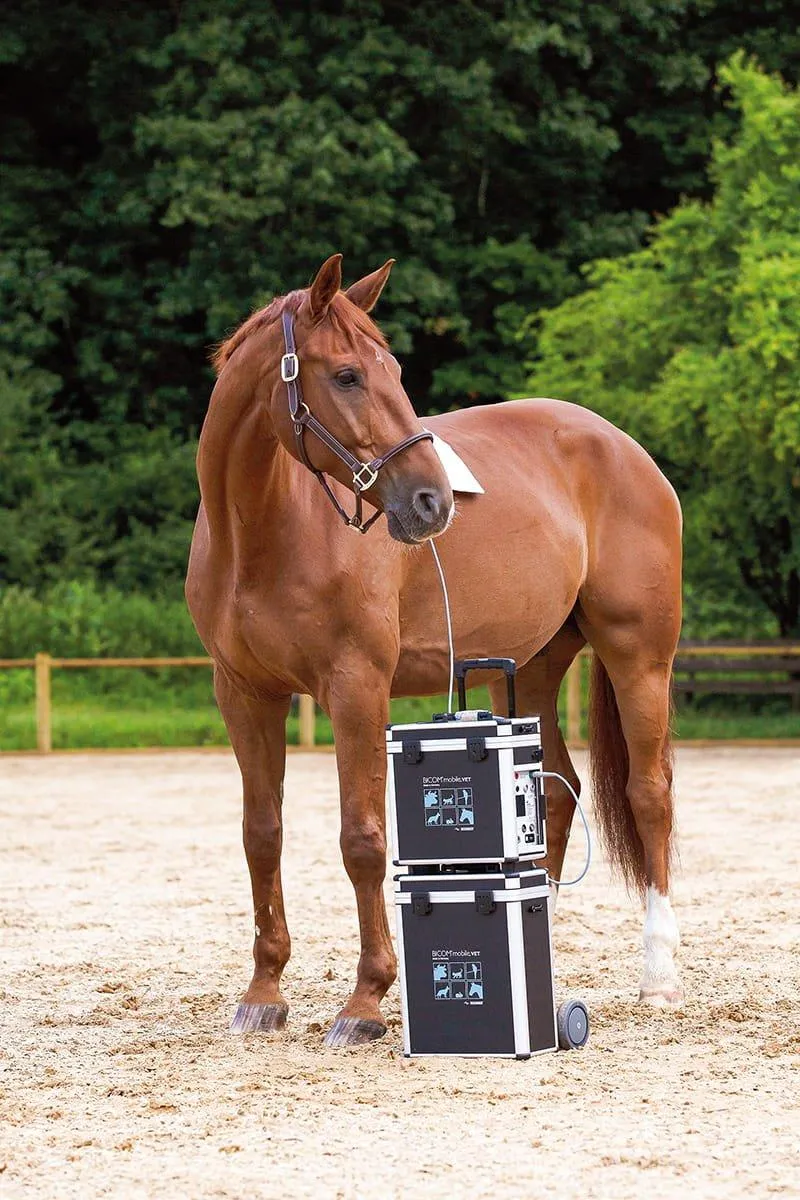Welcome to our veterinary page!
in this section, you can discover what bioresonance therapy is and how it can be a useful tool to enhance your veterinary practice.
Bioresonance therapy is an alternative treatment method that uses electromagnetic frequencies to address imbalances in the body. When applied to animals, it can help to alleviate a range of health conditions by promoting natural healing processes. This non-invasive therapy is gaining popularity among pet owners who are looking for safe and effective ways to support their animal’s well-being. Learn more about bioresonance therapy for animals and how it may benefit your furry friend.
Bioresonance has long been used to identify and target the root cause of a variety of health problems in people. More recently, this technology has also been applied to pets and other animals with much success. BICOM® bioresonance therapy can be used in the treatment of various types of animals, including, Dogs, Cats, Horses, Rodents, Birds and more.
Would you like to know more?
A range of experiences, research and scientific studies into the efficacy of bioresonance treatment can be found on our Blog section. This is where you can view the latest findings and articles about therapy with the BICOM® or browse the article archives.
You can also learn more about the features of the specific devices in the BICOM® range through our therapy machine page. This can help you to see which product will suit you, your clients and your practice best.

Pets with Owners: The Unbreakable Bond Explained
The Unbreakable Bond Between Pets with Owners: A Relationship Built on Love
Pets with owners share a unique connection that goes beyond companionship. Studies show that owning a pet improves mental health, reduces stress, and even enhances physical well-being. Whether it's a dog wagging its tail in excitement, a cat curling up on your lap, or a bird chirping happily when you return home, these moments highlight the deep bond between pets and their owners.
Research indicates that pets recognize their owner’s emotions and respond with affection, comfort, and loyalty. The love between a pet and its owner is built on daily interactions, trust, and mutual understanding, making it one of the most fulfilling relationships a person can experience.
Why Do Pets and Owners Develop Such a Deep Connection?
Scientists and animal behaviorists have studied the relationship between pets and humans for decades. The results consistently show that pets provide not only companionship but also emotional stability, routine, and even physical health benefits.
One of the main reasons pets and owners form strong bonds is their ability to communicate without words. While pets cannot speak, they use body language, vocalizations, and behavior patterns to express their emotions. Similarly, owners develop a deep understanding of their pet’s needs and emotions over time, reinforcing their relationship.
The Science Behind the Pet-Owner Bond
Studies have revealed fascinating insights into the science behind the bond between pets with owners. Research published in the journal Science found that when dogs and their owners gaze into each other's eyes, both experience a rise in oxytocin, often called the "love hormone." This is the same chemical responsible for bonding between human parents and their children.
Additionally, brain scans of dogs show that they recognize their owner’s voice and respond with positive emotions. Cats, while more independent, also exhibit similar bonding behaviors, such as slow blinking, purring, and following their owners from room to room.
Emotional Benefits of Owning a Pet
The companionship of pets with owners is not just about having an animal at home—it significantly affects emotional well-being. Here’s how:
1. Pets Reduce Stress and Anxiety
Spending time with pets lowers cortisol levels, the stress hormone responsible for anxiety. Petting a dog or cat has been shown to reduce blood pressure and induce a calming effect.
2. Pets Increase Happiness
Interactions with pets release dopamine and serotonin, neurotransmitters associated with happiness and relaxation. This explains why many pet owners feel uplifted and comforted after spending time with their pets.
3. Pets Combat Loneliness
Many people, especially those living alone or experiencing emotional distress, find comfort in their pets. Pets provide companionship, making owners feel loved and needed.
4. Pets Encourage Social Interaction
Pet ownership often leads to increased social engagement. Dog owners, for example, frequently meet other pet lovers at parks, strengthening their social networks.
The Role of Routine in Building Up the Pet-Owner Relationship
Consistency is key when it comes to bonding with a pet. A structured routine helps pets feel secure and strengthens their connection with their owner.
1. Regular Feeding Times
Pets recognize feeding schedules and associate meal times with their owner’s care. Over time, this routine reinforces their trust.
2. Daily Walks and Playtime
Dogs, in particular, thrive on daily walks, and even cats enjoy scheduled play sessions. These moments strengthen the emotional bond between pets and their owners.
3. Grooming and Physical Touch
Regular brushing, petting, and even bathing help reinforce trust. Physical touch is an essential part of bonding, helping pets feel safe and loved.
How Pets Communicate with Their Owners
Even though pets cannot speak, they communicate in various ways. Understanding these signals helps strengthen the bond between pets with owners.
1. Body Language
Dogs wag their tails when happy or excited.
Cats slow-blink to show affection.
Birds fluff their feathers when comfortable.
2. Vocalizations
Dogs bark, whimper, or growl to express emotions.
Cats meow differently based on their needs.
Birds chirp or mimic words to communicate.
3. Behavioral Cues
Bringing toys signals a desire to play.
Following owners around shows attachment.
Licking or nudging is a sign of affection.
The Psychological Benefits of Pet Ownership for Humans
The impact of pets with owners extends beyond just companionship. Studies suggest that pet owners experience improved mental health, increased daily motivation, and lower levels of depression.
1. Pets Create a Sense of Purpose
Caring for a pet instills a sense of responsibility and routine. Feeding, exercising, and providing affection contribute to a structured lifestyle, which benefits mental well-being.
2. Pets Help Manage Anxiety and PTSD
Many therapy animals are trained to assist individuals with anxiety, PTSD, and other mental health conditions. Their calming presence reduces panic attacks and provides emotional stability.
3. Pets Promote Physical Activity
Dogs require daily exercise, encouraging owners to stay active. Regular physical activity is linked to lower risks of obesity, heart disease, and high blood pressure.
How Different Pets Form Attachments to Their Owners
While dogs and cats are the most common household pets, many other animals also develop strong connections with their owners.
1. Dogs: The Most Loyal Companions
Dogs are known for their loyalty and deep emotional connection with their owners. They crave interaction, training, and companionship, making them one of the most affectionate pets.
2. Cats: Independent Yet Affectionate
Cats may seem independent, but they form strong bonds through purring, slow blinking, and seeking physical closeness.
3. Birds: Intelligent and Social
Parrots and other birds recognize their owner’s voice and respond to interactions with vocalizations and playful behavior.
4. Small Mammals: Gentle Companions
Rabbits, guinea pigs, and hamsters develop trust through gentle handling and consistent care.
How to Build Up Your Bond with Your Pet
If you want to enhance your connection with your pet, try these strategies:
Spend Quality Time: Engage in daily play, training, or relaxing together.
Use Positive Reinforcement: Reward good behavior with treats and affection.
Understand Their Needs: Recognize stress signals and ensure a comfortable environment.
Respect Their Boundaries: Give pets space when needed to build trust.
The Lifelong Commitment of Pet Ownership
Bringing a pet into your life is a long-term commitment that requires responsibility, patience, and care. Pets depend on their owners for food, shelter, healthcare, and emotional support. Understanding their needs and providing a loving environment ensures a happy and fulfilling relationship for both the pet and the owner.
Responsible pet ownership includes regular veterinary check-ups, proper nutrition, daily exercise, and mental stimulation. Whether adopting a puppy, kitten, or an older rescue pet, it's essential to recognize the lifelong bond and commitment that comes with being a pet parent.
How Pets Positively Impact Family Life
Pets bring families closer by creating shared experiences and responsibilities. Whether it's taking the family dog for a walk, feeding the cat, or teaching children how to care for animals, pets encourage teamwork and bonding.
Studies show that children who grow up with pets develop empathy, responsibility, and better social skills. Pets also provide a source of comfort during stressful times, making them invaluable members of the household.
Conclusion
The connection between pets with owners is one of trust, love, and mutual understanding. Scientific studies confirm the numerous emotional, psychological, and physical benefits of having a pet. Whether it's a dog eagerly waiting at the door, a cat curling up beside you, or a bird singing in the morning, the bond between pets and their owners is truly special.
Owning a pet brings unconditional love, daily companionship, and a lifetime of cherished memories. Strengthening this bond through care, communication, and routine ensures that the relationship remains fulfilling for both the pet and the owner.
Pets with owners share a relationship that is loyal, loving, and unbreakable.
FAQs
1. How do pets benefit their owners emotionally?
Pets provide companionship, reduce stress, and increase happiness by offering unconditional love and emotional support.
2. Can pets recognize their owners?
Yes, pets recognize their owners through voice, scent, and visual cues, forming a strong bond over time.
3. Why do pets follow their owners around?
Pets follow their owners for security, companionship, and to seek attention or food.
4. Do pets understand human emotions?
Yes, pets can sense emotions through body language, tone of voice, and facial expressions.
5. What are the best ways to bond with a pet?
Spending quality time, engaging in play, training, and providing consistent care strengthens the bond.
6. How does pet ownership improve mental health?
Pets help reduce anxiety, combat loneliness, and provide a sense of purpose and routine.
7. Why do dogs and cats show affection differently?
Dogs express love through wagging tails and licking, while cats show it by purring, slow blinking, and cuddling.
8. Can pets miss their owners?
Yes, pets can experience separation anxiety and show signs of missing their owners when apart.
9. How do pets communicate with their owners?
Pets use body language, vocalizations, and behavioral cues to express emotions and needs.
10. What is the best way to make a pet feel loved?
Providing consistent care, affection, training, and playtime ensures a pet feels loved and secure.
Quick Links





Facebook
Instagram
Mail